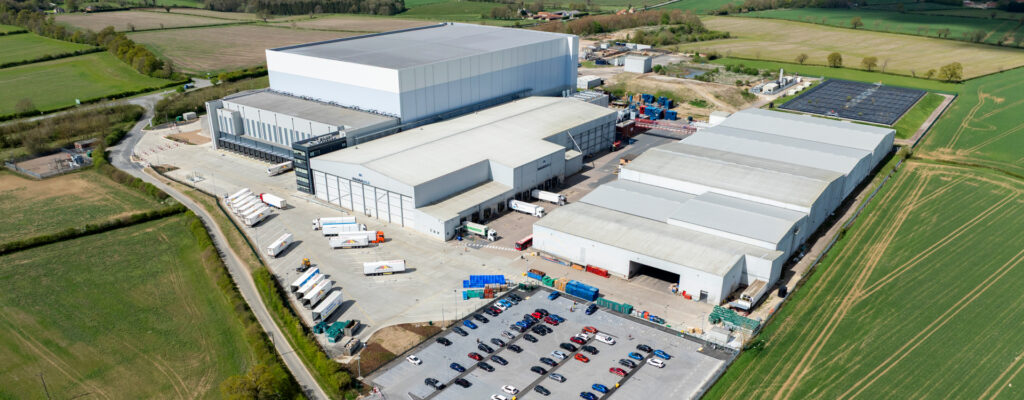Why choose adhered single ply roofing systems?
Adhered single ply roofing systems are particularly popular in the UK flat roofing market.
They are chosen for a myriad of reasons such as achieving a more aesthetically pleasing roof finish, avoiding the need to predrill into a concrete roof deck or the need for several fixing and tube lengths when installing a tapered insulation scheme, high humidity building use applications such as swimming pools or just simply installer preference.
Choosing the right adhesives for single ply roofing projects is critically important for the performance of the roof.
There are many choices of adhesives within the flat roofing market, even perhaps multiple choices for the same application from a single source system supplier such as IKO Polymeric.
The aim of this blog article is to provide an overview of what is available and help you to choose the right adhesives for single ply roofing projects, bearing in mind that the choice and correct application technique is critical to the performance of the roofing system.
After-all the adhesive must resist wind uplift forces as well as thermal and structural movement imposed over the lifetime of the roofing system.
All IKO Polymeric adhesives have been subjected to independent wind uplift testing to establish their suitability in our roofing systems and a wind uplift calculation is undertaken for each project to ensure that an adhered solution is suitable.

Right adhesives for single ply roofing
Although there are many different types of adhesive available the most common types used in single ply roofing systems are:
Single part polyurethane (PU)
These are generally considered high performance adhesives that can be modified to foam to different levels depending upon the application requirement. They can be applied with a brush, roller, spray system, or poured direct from the can.
They are cured by the moisture present in the atmosphere and should not be applied in temperatures below 5⁰C. PU adhesives are particularly suitable for flat roofing as once cured they remain strong and durable in temperatures as high as 140⁰C.
However, when used to bond two non-porous surfaces together such as foil faced insulation boards, a longer cure time may be experienced which could delay roofing works.
Two part polyurethane (PU)
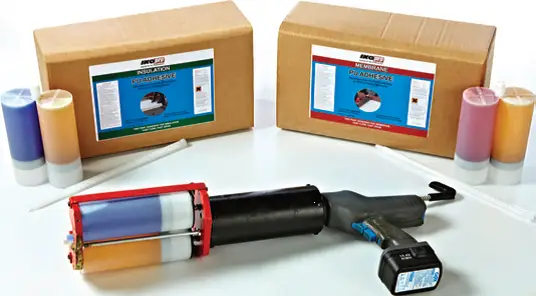
Solvent-based synthetic rubber contact adhesives
These are single component adhesives that are applied in two coats by brush, roller or spray; one to the back of the membrane and one to the substrate. Once the adhesive is tacky on both surfaces they are pressed together, and pressure applied to consolidate the two adhesive layers to become one.
This gives an instant bond so is ideal for vertical applications. Generally, these are used for details and upstands but can be used to bond large field areas if care is taken. Issues arise with contact adhesives if the two surfaces are put together at the incorrect time.
If the surfaces are too wet with adhesive, it’s possible that the solvents have not flashed off adequately. This can lead to solvent blisters forming between the substrate and the membrane.
Conversely if the surfaces are too dry, it becomes impossible to get the two layers to consolidate and a proper bond is not achieved. Contact adhesives should not be applied in temperatures below 5⁰C.
Water-based acrylic adhesives
These single component adhesives are brush or roller applied to the substrate. They are generally not used for adhering membranes on site as they cannot get dry in low temperatures below 10⁰C. They can however be used in factory conditions easily so are a good solution to bond membrane in offsite construction production facilities.
Whatever the adhesive type, it’s important that the surfaces to be bonded are dry and free of dust and other loose particles and contamination. The adhesive is only as effective as the material it’s bonded to.
Temperature is critical when using adhesives and they all have lower working limits. Lower temperatures tend to make the products more viscous making them more difficult to apply, they will also take longer to cure.
On the other hand, in warmer temperatures adhesives will dry faster giving the operative less working time. Working methods need to be adjusted to take this in to account.
Bonding insulation boards
Insulation boards are generally bonded by applying strips or beads of adhesive to the substrate using a high foaming PU adhesive. The high foaming nature of the adhesive allows for any unevenness of the substrate by filling any gaps or small ridges that may be present.
The bead widths can vary depending on the product being used and the substrate that the insulation is being bonded to. The bead centres vary depending on the wind uplift forces calculated for the roof area. But they will typically be 50% closer together in the corner and perimeter zones where the uplift forces are higher.
Adhesive bond tests may be required when bonding to existing substrates to ensure suitability of the product. Consumption rates of adhesive will increase on absorbent materials such as mineral wool insulation or when bonding to uneven substrates.
Right adhesives for single ply roofing – supplied by IKO Polymeric
IKOpro High Performance PU Adhesive
- Easy to Apply – pour from can application.
- Fast Drying.
- Weather resistant long-lasting bonds.
- Suitable for most Insulation types.
- No tooling costs.
- Extended cure times when bonding two non-porous substrates (multi-layer foil faced insulation boards).
- Not suitable for application when temperatures are below 5⁰c.
Click here to find out more.
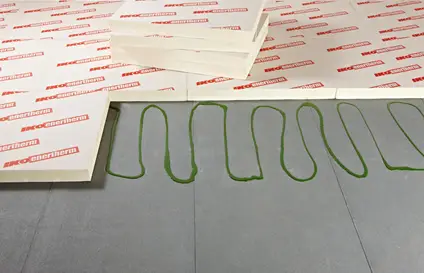
IKOpro Fastick Two Part PU Adhesive for Insulation
- Rapid Drying times (10-15 minutes).
- Weather resistant long-lasting bonds.
- Suitable for all insulation types.
- High initial tooling costs, however, guns are robust and long lasting if maintained correctly.
- Not suitable for application when temperatures are below 0⁰c.
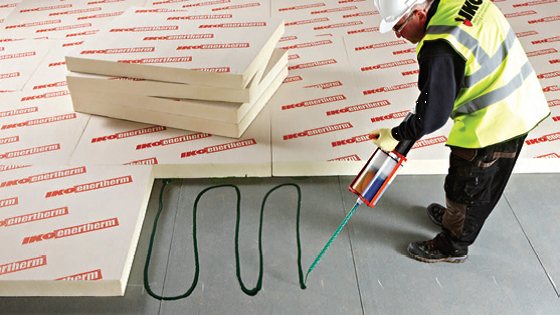
IKOpro Sprayfast IBA PU Adhesive for Insulation
- Rapid drying times (30-45 mins).
- Weather resistant long-lasting bonds.
- Suitable for all insulation types.
- Low-mid tooling costs.
- Fast installation time.
- Reduces risk of back pain.
- Tooling maintenance required.
- Foam structured product that requires minimum foot traffic for 10-15 mins.
- Not suitable for application when temperatures are below 5⁰c.
Click here to find out more.
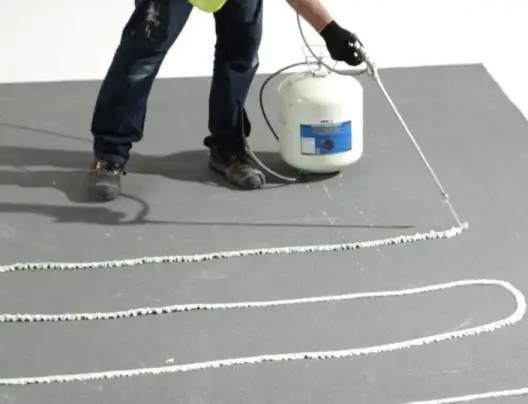
Bonding waterproof membranes
Membranes are generally bonded by applying a full even coat of adhesive to the substrate (and reverse of the membrane if using contact adhesive) and consolidating the 2 materials together using pressure applied by a roller or soft broom.
Spectrabond Low Foam PU
- Easy to Apply – roller or squeegee.
- Fast Drying.
- Weather resistant long-lasting bonds.
- Suitable onto all types of fleece-backed membrane.
- Low tooling costs.
- Bitumen & polystyrene compatible.
- Not suitable for application when temperatures are below 5⁰c.
- During colder temperatures, product becomes harder to apply at consistent coat weight and application speeds.
- Not suitable for non-fleece backed membranes.
- Sloped/vertical applications need additional fixing to prevent slippage during drying period.
Click here to find out more.
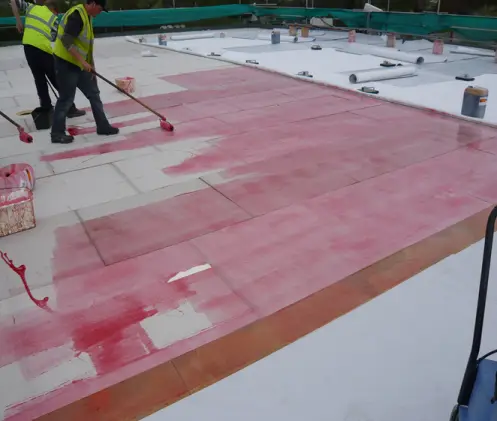
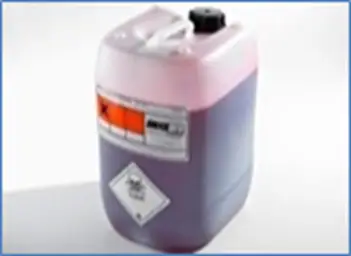
Sprayfast FMA PU
- Rapid Application rates (up to 10 metres/minute) even in cold temperatures.
- Fast Drying.
- Weather resistant long-lasting bonds.
- Suitable onto all types of fleece-backed membrane.
- Low-Mid tooling costs.
- Reduces risk of back pain.
- Bitumen Compatible.
- Tooling maintenance required.
- Not suitable for application when temperatures are below 5⁰c.
- Not suitable for non-fleece backed membranes.
- Sloped/vertical applications need additional fixing to prevent slippage during drying period.
Click here to find out more.
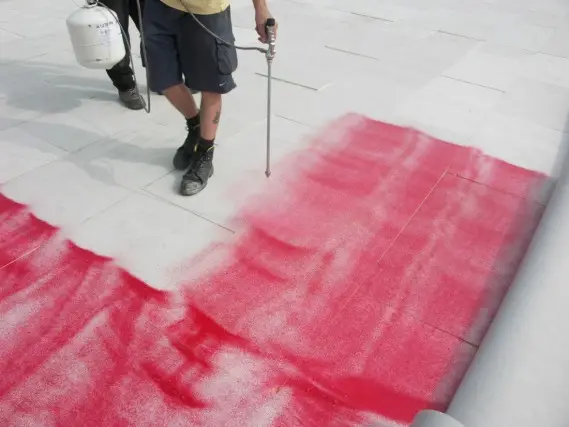
PVC Contact Adhesive
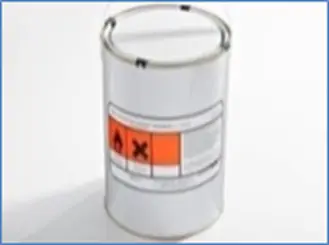
- Easy to apply – brush or roller.
- Fast drying times.
- Weather resistant long-lasting bonds.
- Suitable for non-fleece backed PVC.
- Low tooling costs.
- Instant bond.
- Suitable for vertical application.
- Drying times and application rates are affected by lower temperatures.
- Not compatible with bitumen and plain faced polystyrene insulation boards.
- PIR insulation boards must be taped.
- Not suitable for application when temperatures are below 5⁰c.
Click here to find out more.
Sprayfast PCA PU Contact Adhesive
- Rapid application rates (up to 10 metres/minute) even in cold temperatures.
- Longer working times, (up to 20 minutes).
- Weather resistant long-lasting bonds.
- Suitable for non-fleece backed PVC.
- Low-Mid tooling costs.
- Reduces risk of back pain.
- Bitumen Compatible.
- Tooling maintenance required.
- Not suitable for application when temperatures are below 5 degrees C.
Click here to find out more.

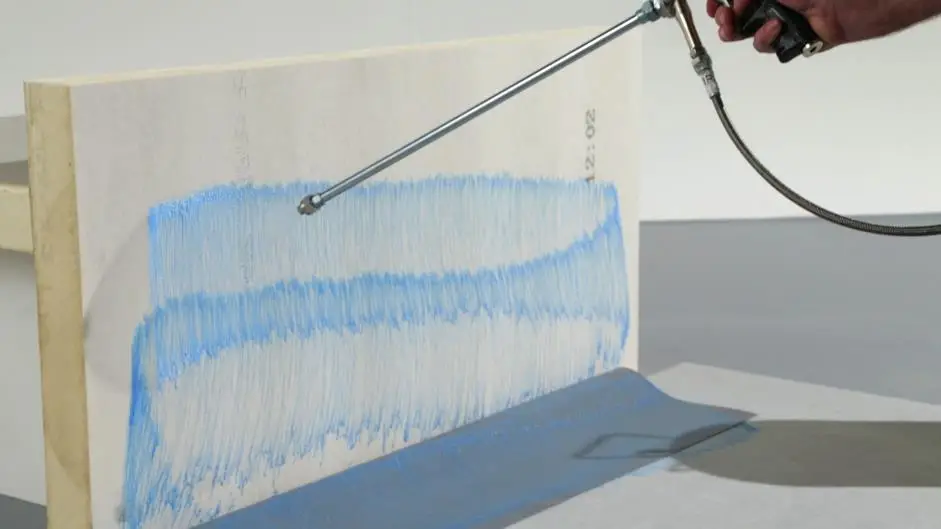
If you’re stuck trying to choose which IKO Polymeric system adhesive to use, or need some advice on application or tooling, don’t hesitate to contact our technical team on technical.polymeric.uk@iko.com or 01257 488 012.


